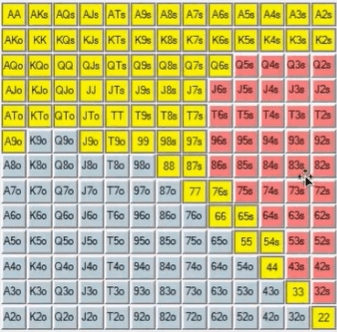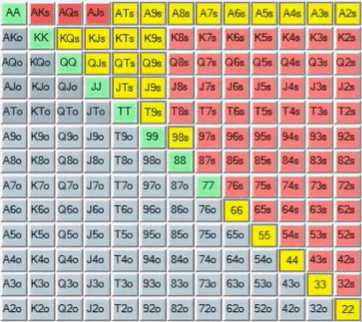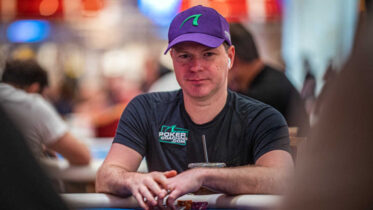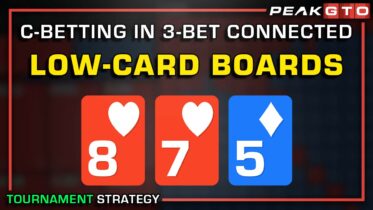Although both are popular amongst poker players, there are significant differences between cash games and poker tournaments. If you are a cash game player, you are probably used to playing a lot of hands, seeing plenty of streets, and always having more than 100 big blinds in front of you. Poker tournaments are a completely different beast, requiring you to consider many nuances when learning how to play and adjust. If you are a cash game player looking to break into the poker tournament scene, knowing how to play poker tournaments requires making the right adjustments.
Overall Poker Tournament Adjustments
Surviving Poker Tournaments
It is critical to realize that poker tournaments are about survival. Once you are eliminated from a poker tournament, there is usually no coming back, which means you must value your tournament life. In poker tournaments, you will often be presented with marginal spots that are better off being passed up in order to protect your stack. You will find a lot of pros that are critical of this mindset, but making the final table in large field poker tournaments requires you to first survive day one, survive day two, and reach the money bubble. While you should always take calculated risks, be sure you are being offered the correct odds before committing large amounts of chips.
Adjusting Preflop Raise Sizes
Playing in a $2/$5 cash game, the blinds will always stay at $2 and $5 throughout a session. Poker tournaments, however, have blinds that continuously increase, resulting in raise sizes changing as stacks get smaller. Lowering your preflop raise sizes as your stack gets lower provides you with more playability. The larger the pot means the larger bet sizes will be on the flop, turn, and river. Raising for a small amount with your preflop strategy will you help dictate bet sizes for future streets.
What To Consider When Making Tournament Adjustments
Cash game players transitioning to poker tournaments must become comfortable playing short stacked. The biggest adjustment to make when playing with a short stack is getting comfortable folding more hands. Not only should you adjust your range as your stack size changes, but you should also be taking note of the other stacks at your table. A three-bet against one opponent may be a shove facing another, be mindful of the table’s stack composition when evaluating your options. Although effective stack sizes are a key factor when making decisions in poker tournaments, the following factors should be noted as well:
- Position
- Stage of Tournament
- Opponent Type
- Game Flow
- History (How Have They Played In The Past?)
Preflop Adjustments In Poker Tournaments
Preflop Raise Sizes In Poker Tournaments
Not only do you play almost exclusively deep stacked in cash games, but what is considered “deep stacked” differs greatly between a cash game and a tournament. While deep stacked in a cash game can mean anything over 150 big blinds, in a poker tournament this number drops to 60 big blinds. In a tournament, your stack size should dictate what your preflop raising size should be. A deep stacked poker player in a tournament can raise 3 big blinds, but as the tournament progresses their preflop raise size should move closer to 2 big blinds.
Preflop Hand Selection
As your stack size dwindles, your hand selection becomes more and more crucial. While a hand can be profitably played with a stack of 60 big blinds, at 30 big blinds the same hand may not be profitable. Your stack size as well as your position should greatly influence your preflop range and hand selection. Although poker in the modern era sees more players opening up their ranges, when adjusting your own hand selection you must be mindful to not open too-wide when short stacked.
How Players Play Later In Tournaments
Since they can always add on to their stack and don’t have to worry about being eliminated from play, cash game players will typically stick to their strong ranges and not deviate too heavily from their default strategy. Unlike cash game players, poker tournament players will get more creative in their play the deeper they get into a tournament. Poker tournament players will implement more three-bets, widen their defending range from the big blind, and will attempt to trap more often the longer they last.
When a player is down to just 15 big blinds, they do not have many opportunities to make moves and avoid blinding out, requiring them to make aggressive plays. Between 30 to 10 big blinds effective, you must know which hands are worth risking your tournament life with in specific spots. Playing short stacked, you will make aggressive all-in moves often, making it essential you know the proper ranges to shove with depending on your stack size and position.
First To Act In A Poker Tournament

Raising Hands Marked In Yellow
When first to act 40 big blinds deep in a tournament, above is the standard range you want to adhere to. While you would rarely open hands like K-7 and K-6 suited under-the-gun (UTG) in a cash game, in a tournament these hands are raised with UTG. Some poker players may elect to maintain a tighter UTG range than the one shown, but widening your range will make you harder to play against in poker tournaments. As tournament poker players develop looser ranges and strategies, the more hands you will likely see added to an optimal UTG opening range with 40 big blinds.
While we know what an UTG opening range looks like at 40 big blinds, let us consider what an opening range looks like from the cutoff with 20+ big blinds.
Playing A Poker Tournament Hand In Late Position

Raising Hands Marked In Yellow
Despite having less chips than in the previous example, in late position you are raising with 30% of hands. While it feels great when you are finally dealt aces and are able to cooler an opponent, relying on the deck will not reward you with many final table appearances. You must become comfortable expanding your range. Many players may be uncomfortable raising a hand like Q-6 suited from the cutoff, but a proper GTO raising range includes such hands. You could even get away with including hands like A-5 offsuit in your cutoff opening range as well. If there are opponents yet to act who are weak players, do not be afraid to widen your range to exploit them. Transitioning to tournament play, cash game players are not used to playing with such wide ranges, but knowing what hands to play preflop is essential to success.
Facing A Preflop Raise In A Poker Tournament

Chart Information: Green = Call, Dark Red = All-In, Yellow = All-In,
Grey = Fold, Light Red = Fold
While we have covered how ranges and stack sizes affect your preflop raising strategy, what should your range look like facing a raise when short stacked? The above chart displays what your range should be from the button/blinds with 15-25 big blinds facing a late position raise. The majority of hands you shove with (in yellow) are vulnerable hands that have good playability, such as small pocket pairs and suited connectors. If an opponent in late position is adhering to a reasonable opening range, they will have plenty of foldable hands you can exploit by shoving.
When holding strong, suited connectors, players will call preflop raises hoping to see the flop before committing the rest of their chips. Although it requires some risk, moving all-in with these hands is better than calling. You would much rather get all of your chips in the middle preflop than attempt to navigate multiple streets with only a few chips to play with. By moving all-in preflop with strong, suited connectors, not only will you induce folds, but you keep your opponents from realizing their equity on the flop. When your opponents fold, you will scoop up valuable chips late in tournaments, and when they call you will have a hand that can easily catch up if behind.
Marked in green are hands that can be three-bet. If your opponent goes all-in in response to your three-bet, these hands are strong enough to call off with. Although pocket aces and pocket kings are predictably hands you want to raise with, pocket eights and sevens also play well as three-betting hands but can be shoved with as well.
If you are facing a passive opponent who will fold to a three-bet, you can even add hands like A-10 and K-J offsuit to your short stack shoving range. 15-25 big blinds may not seem like a lot to a cash game player, but in a poker tournament it is just enough to mount a comeback. Implementing an aggressive short stack shoving strategy will allow you to scoop up 4-5 big blind pots, which are critical in sustaining survival late in poker tournaments.
Postflop Adjustments In Poker Tournaments
The Importance Of Stack Sizes
Many of my postflop adjustments mirror fundamentally sound cash game strategies. One such strategy is being aware of stack sizes, and using that info to influence your bet sizing. Stack sizes are an even bigger factor in tournaments as there will be times you will be forced to play for your tournament life, a factor not present in cash games. Considering details of a hand such as your opponent’s stack size, position, pot size, and what your strategy is for future streets will take you far in poker tournaments.
Be Cautious Bluffing Multi-Way
When you find yourself playing postflop in a mutli-way pot, it is critical you exercise caution with your bluffs. Having more than one opponent means having to get your bluff through at least one other person, dramatically changing your odds of success. Cautious bluffing is even more critical the deeper into a tournament you are. In the early stages of poker tournaments, the deeper stacks and lower blinds allow players to see more flops and call wider ranges. In the middle and late stages of poker tournaments, most hands will be heads-up due to stacks being shorter. If all of a sudden you are in a multi-way pot with 25 players remaining, odds are your opponents have strong ranges.
Making the proper postflop tournament adjustments also means building pots with the right hands. The best time to build the pot postflop is when you have a high value hand or when you have no equity with the range advantage. When you lack the ability to win at showdown, utilize your range advantage as it is the only way you will win such hands. Being able to represent a strong range allows you to bluff more effectively and steal pots. Knowing how to strategically bluff will give you an edge in any poker tournament.
Playing Marginal Hands In Poker Tournaments
Sometimes you will be in a spot holding a hand in the middle of your value. When holding a middling hand, controlling the size of the pot is of at-most importance. A lot of the time, these middling hands have a decent chance of winning at showdown. By keeping the pot small, you have a better chance of making it to showdown and potentially winning the hand.
Although concepts like playing aggressively with high value hands and controlling the pot with middling ones are not foreign to cash games, knowing how to apply them to tournaments will take you far on the felt.

Make the best preflop decisions with Jonathan Little’s Push/Fold Charts!
Understanding Poker Tournament Stages
Nittier players will play overly tight even at the beginning of tournaments to avoid risking elimination, but for the most part, you will see more hands having postflop action unless a tournament is a freezeout. Since all players start deep stacked at the beginning of poker tournaments, a lot of early stage play resembles cash games. The freedom of a deep stack allows cash game players to play their usual ranges and approach each hand with their usual strategies.
The Early Stages Of Poker Tournaments
Early in tournaments players will play more hands and eventually adjust to their opponent’s tendencies and ranges. It is critical that you treat the early stages of poker tournaments as an “information gathering” phase. The information you pick up on your opponents early on can help you greatly when you face them in the later stages of a poker tournament. As tournaments progress, players begin to play differently to adjust to their fluctuating stack sizes. It may sound crazy, but sometimes the same player who plays like a maniac deep stacked will willingly fold pocket jacks once they are down to 25 big blinds. While making mental notes of player tendencies is critical, be sure to not overexert yourself categorizing every single player you face.
At the beginning levels of a poker tournament, postflop play is what separates the good players from the bad ones, but as tournaments get deeper, preflop play is the name of the game. Hand selection becomes more critical the longer a tournament lasts. By selecting the right hands preflop you give yourself the best chance of succeeding postflop.
When To Risk Your Poker Tournament Life
When short on chips, it is imperative you know when, why, and how to play all of the hands in your range. Whether you have 30 big blinds with pocket fours or 12 big blinds with A-J offsuit, you must be prepared for every situation in every position. Note your opponent’s range, stack size, and position to make the best decisions possible late in tournaments.
Sometimes the outcome of a tournament can simply come down to which player had position on the other. A player raises the button and you have pocket fours with 15 big blinds remaining from the small blind. You should be ripping here nearly 100 percent of the time, but sometimes your opponent will have pocket aces and beat you. Even though you may lose some hands, this is still the best play to make, and losing shouldn’t discourage you from making this play in the future.
All you can do is make the best decision with the information available to you and let the cards fall where they fall. Since tournaments force us play short stacked and make calculated risks for our tournament life, the variance for a tournament player is much more dramatic than for a cash game player. If you plan on only playing poker tournaments, be sure to know how to properly be bankrolled and be prepared for these swings.
Conclusion
I hope this article gives a good understanding of the nuances between cash games and poker tournaments. While written for cash game players looking to transition to tournaments, this piece provides concepts even tournament players can benefit from studying. Comprehending how much you need to study prior to tournaments and in what ways to alter your game when you run deep is how you become a profitable poker player. While the swings of live and online poker tournaments can make cash game players wary of attempting them, there is profit there for those willing to apply themselves.




